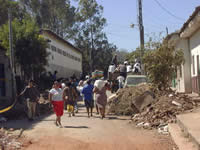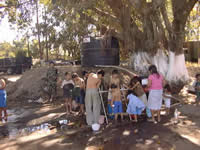|
July 21, 2005
Doctors without Borders - El Salvador, After
the Earthquake
Just yesterday I completed an interview with Doctors
Without Borders/ Médécins Sans Frontières
(MSF) and while researching their website, I found that some of
the volunteers at MSF
had written really interesting stories about their experiences in
foreign countries. MSF gave me the permission to republish some
of these stories, I think you'll find them very interesting since
they shed light on the situation of the local population and the
experiences of the volunteers in some of these far away places.
El Salvador, After the Earthquake
By David Morley
Thursday 25 January 2001
In the morning the team meets in the MSF house in San Salvador.
The teams have come from around Central America, volunteers who
were working on AIDS projects in Guatemala, water projects in Honduras,
from the Emergency Preparedness Office in Costa Rica, and the people
who have come here for this emergency. They plan the day's activities;
who will go to Armenia - one of the hardest hit towns - to support
the building of a little cholera centre in the hospital there; who
will go to Cafetalon, to continue our mental health and water programs
for the 7,000 people from Santa Tecla and neighbouring towns who
are living in the football field and who, unless things change,
will be there for quite a while yet.

Vincent Brown, who has come here from Epicentre, the MSF research
centre in Paris, briefs us on the data he has collected on diarrheal
and respitorial problems in the country, and how these figures should
help the team plan the next steps.
Then we are off to Armenia. Armenia is just 40 minutes from San
Salvador, but it could be on another planet. The busy boulevards
of San Salvador, with their MacDonald's and Pizza Huts and car dealerships,
look like any other bustling Latin American capital. Armenia, before
the earthquake, would have looked like a provincial Latin American
town. The Central Square dominated by its church, one storey buildings
made of brick and adobe. A sleepy place.
Now, it looks like the aftermath of an aerial bombardment. There
is rubble everywhere in the streets. In every block of houses one
is gone, replaced by a pile of bricks, mortar, wood, and tin. Occasionally
you can see broken pieces of tables and beds. You would never ever
guess that these piles could have ever been homes full of life.
They look like they have always been this way, piles of useless
rubble. For street after street after street the destruction goes
on.
The destruction is even worse than it first appears. Many of the
fronts of houses are still standing, but behind them there is just
rubble. Many people are sleeping in the streets, underneath makeshift
plastic roofs. It will take 2,000,000 sheets of zinc to provide
the most rudimentary reconstruction. The largest manufacturer here
in El Salvador produces 100,000 per year. How long will it be before
these people have their homes again?
A bookcase peeps out of one little green plastic tent in front
of a pile of rubble - a student must live there. Down another street
a group of mourners sit around a coffin. They are bathed in a blue
light cast by the plastic sheeting which has been strung above them
as an awning. An elderly man tosses great chunks of stone from the
wreck of his house into the street while his grandson diligently
works beside him trying to rebuild his tricycle. And everywhere
you see beautiful red, purple and white blooms of bougainvillea
looking impassively over the rubble surrounding them.
I cannot imagine the power that it must have been to wreak such
havoc, to turn so many homes into nothing. I have been in earth
tremors, and they are frightening, but this earthquake - what can
it have been like to see your home, your street, your community
shaken and shaken until it falls apart? It was on a Saturday morning,
a day no different than any other, and suddenly your daily life
is destroyed.
Some people are living in makeshift camps. MSF provides the water
in San Martin. "Everyone pitched in," says Claudine, an
MSF volunteer from Belgium. "We shared the work in this camp
with Unicef and Action Contre le Faim."
In the middle of town MSF is supporting the work of the local clinic.
We will use a garage to build a little centre to treat diarrhea.
Pierre, a French engineer who drove supplies here from the MSF emergency
stockpiles in Honduras, works with the Salvadoran health staff how
the centre will look. "We'll use plastic sheeting to make the
walls and divisions for the men and women. We have to make channels
for the water so it doesn't contaminate that cistern over there.
We need to string 2 by 4s there so we can hang the rehydration IV
bags." They draw rough plans in their note books. "Do
we have the cement we need to make the channels? It's in San Salvador,
we can bring it tomorrow morning and we'll be done by Saturday."

A Health Official comes up and asks Claudine if we can help them
do a fumigation of areas at risk of dengue fever. "We did a
dengue campaign here in the fall, we have trained some local health
promoters. It's good to see that they have seen the signs and are
taking the initiative to come to us for help."
Then we go to Santa Tecla. This is the community that was hit with
the mudslide, the town whose suffering has been on TV screens around
the world. The victims are living in a football field. "When
we arrived last Monday," says Pierre, "everyone was living
in makeshift huts. We got the water system running with the tanks
and the plumbing supplies we brought from Honduras, and the Red
Cross brought in some tents. This is the kind of place where, if
you don't get the sanitation down fast, cholera can kill before
you know it." In two days a cholera centre was built on a basketball
court beside the soccer field, with all the different sanitation
zones, drainage, water supply and tents. Latrines and washing stations
were built at different places around the football field - which
is now home for more than 7,000 people. MSF built a hut and distributes
Oral Rehydration Solution and we are also running a mental health
program to try and help people deal with the psychological trauma
of this catastrophe.
So far, there is only one suspected case of cholera. "If we
are really lucky," says Pierre, looking around the empty cholera
centre, "we will never have to use this place. We moved fast
here, and maybe there won't be a cholera outbreak. But in 1986,
last time there was an earthquake here in El Salvador, some people
had to live in tents like this for six months, so it is good that
we've built this well. If it doesn't have to be used for cholera,
we will find another use for it. It could be used as a school or
a community centre." The great thing is that almost all of
this material is re-useable. The tents, the plastic sheeting, a
lot of the wood - when this crisis is finished we will store it
all again and be ready for when the next emergency hits.
"Basic hygiene is so important," he says. "In our
emergency kits we include soap, towels, washing up things, plates
and utensils. These help keep people healthy."
At the end of the day, people come back to the MSF office in San
Salvador. It has been a hot day, and everyone is sticky and dusty.
In one room the water and sanitation people work on the design for
a latrine. In another, people pour over health statistics from another
community and ponder if we can help there, too. The mental health
team sits quietly together, debriefing after the day's work. The
sun has set, and the temperature cooling off. Another day is over.
By David Morley
www.msf.ca
Related Articles:
Read my interview with Doctors
without Borders
Doctors without Borders: Visiting
an Afghan Refugee Camp
Doctors without Borders: El Salvador,
after the Earthquake
Doctors without Borders: Water
for Ixtahuacan
Doctors without Borders: Visiting
MSF in Sierra Leone
Doctors without Borders: Lost between River
and Sky
Doctors without Borders: Journey
into the World of Humanitarian Aid
|